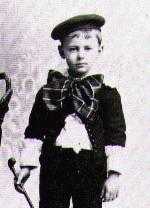
Bows on Boys' Collars: Chronology
|
The use of bows as fancy neckwear varied greatly over time. We do not notice them being worn in the first half of the 19th century. We see stocks at mid-century. Gradually we begin to see bows tied in carious knots. At first the T-bow ribbon knots were the most common. Gradually floppy bows become more popular and the sizes begin to increase. Floppy bows became huge. The largest bows were worn by the smallest boys. They became all the rage in the late 19th century and early 20th century but rapidly went out of style after World War I. This appears to have been a generalized pattern in Europe and North America. There may have differences among countries. The popularity and sizes of the bows, for example, seems to have especially strong in America.
18th Century
We do not yet have information on 18th century collar bows. An imprtant factor here is that there were not yet dedicated children's fashions. Children basically wore cut down versions of their parent's clothing.
Early 19th Century (1800-40)
Boys blouses in the late 18th century and early 19th century were usually worn with open necked, often ruffled collars. Bows were not commonly worn during this period. This open-necked, open collar was the style for boys up to their teens. This open collar style continued into the 1820s and was worn with a variety of garments,inclding the skeleton suit and smock. This comfortable-looking style seems pefectly suited for boys and stands in stark contrast to the closed-neck collars and huge bows that boys were wearing by the end of the century. It is another example of how fashions can change and how in many cases they are unrelated to practical needs, but rather reflect social, economic, and psychological, and other trends.
Mid-19th Century (1840-70)
As the century progressed, closed collars became increasingly common. At mid century the stock became standard neckwear. They were very common with adults, less so for boys. We see boys wearing
small nows that do not look too different thab stocks. Here it is sometimes difficult to make out detail. A good example is a younger American boy in 1855. We notice an unidentified American boy about the small plaid bow about the same time. Some of these bows look more like bowties than the floppy bows that would begin to become popular in the 1870s.
Boys might wear a kind of bowtie at the collar or a small slender bow. Large floppy bows, however, were not common. As the 19th Century progressed, closed collars and at first ties of various description became more common and gradually larger. Boys began wearing bow ties in the 1850s and 60s. We see bows that still seem to have atock base, but with tails appearing. A good example is the American Lathrop brothers in 1855.
Gradually modest bows began to appear on younger boys. Soon a wide variety of different sizes and colors were introduced. Bows in the 1860s and 70s were generally small and usually black. While we see boys wearing bows, more commonly boys did not have neckwear. A good example here is the Wallis brothersWallis brothers in 1852. We note boys with stock-like bows into the 1860s. A good example is American boy, Augustus Davies.
Late-19th Century (1870-1900)
Floppy bows were widely worn by boys in the late 19th century. Boys wore floppy bows in a range of sizes. The late 19th Century saw collar bows reach the peak of their popularity. In the 1880s the sizes of the bows often increased and a greater variety of colors and even patterns became fashionable. The larger bows worn in the 1880s appear to be a direct result of the Fautleroy craze which swept the nation. The growing sizes of the bows was in part due to the large size of the lace collars worn with the increasingly popular Fauntleroy suits. Yje colorful bows added a bit of color to the Fauntleroy or other dark-colored suits. Apparently many mothers felt that a small stringy bow would look out of place with a large lace collar. We note floppy bows with other types of clollars such as Eton collars. A good example here is an unidentified American boy in the 1890s. Boys' collars grew larger and larger as fawning mothers waged a veritable arms race to see who could put the largest collar, often lace collar, on their sons. Along with the large collars went larger and larger bows. Not all boys wore bows with their collars, but most did.
Early 20th Century (1900-30)
Large bows remained popular at the turn of the Century and were still commonly seen in the 1900s. Some quite large bows were still worn, but even in the 1900s the bows were smaller than in the late 19th century. Ruffled collars were had largely replaced lace collars and boys began wearing smaller bows, or on some cases, no bows at all. Bows began to noticeably decline in size and popularity in the 1910s. After World War I, large neck bows are no longer commonly seen, although some boys wore then for a few more years. A good example is
Geordie, a Canadian boy in 1922. Younger boys might still wear floppy bows in the 1920s, but they were no longer worn by the 1930s.
HBC
Navigate the Boys' Historical Clothing Web Site:
[Return to the Main neckwear bow page]
[Introduction]
[Activities]
[Biographies]
[Chronology]
[Clothing styles]
[Countries]
[Bibliographies]
[Contributions]
[Essays]
[FAQs]
[Glossaries]
[Images]
[Links]
[Registration]
[Tools]
[Boys' Clothing Home]
Created: March 17, 1999
Last updated: 9:47 AM 2/17/2015


